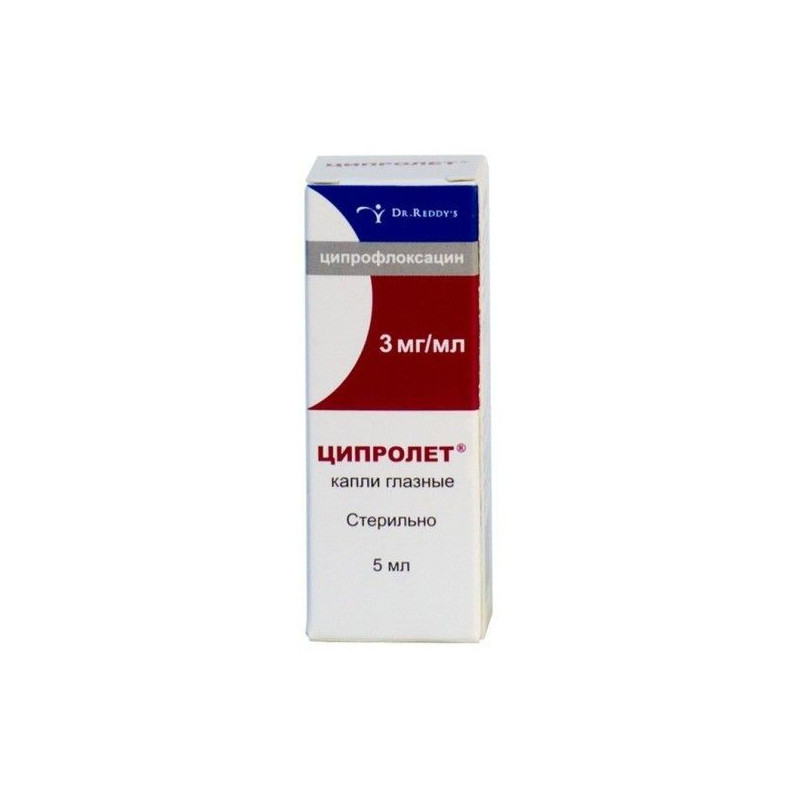



 All payments are encrypted via SSL
All payments are encrypted via SSL
 Full Refund if you haven't received your order
Full Refund if you haven't received your order
Eye drops
1 ml of solution contains: USP Ciprofloxacin hydrochloride (equivalent to 3.0 mg Ciprofloxacin) 3.49 mg / ml.
Excipients: disodium edetate, sodium chloride, benzalkonium chloride 50% solution, hydrochloric acid, water for injection.
Bottle of 5 ml.
Ciprolet - broad-spectrum antimicrobial agent, a derivative of fluoroquinolone.
Ciprofloxacin inhibits bacterial DNA gyrase (topoisomerase II and IV, which are responsible for the supercoiling of chromosomal DNA around nuclear RNA, which is necessary for reading genetic information), violates DNA synthesis, growth and division of bacteria. Causes pronounced morphological changes (including the cell wall and membranes) and the rapid death of the bacterial cell. It acts bactericidal on Gram-negative organisms in the period of rest and division (as it affects not only the DNA gyrase, but also causes lysis of the cell wall), on gram-positive microorganisms it acts only during the division period. Low toxicity to cells of the microorganism is explained by the absence of DNA gyrase in them. While taking ciprofloxacin, there is no parallel development of resistance to other antibiotics that do not belong to the group of DNA gyrase inhibitors,which makes it highly effective against bacteria that are resistant, for example, to aminoglycosides, penicillins, cephalosporins, tetracyclines, and many other antibiotics.
Ciprofloxacin sensitive:
Gram-negative aerobic bacteria: Escherichia coli, Salmonella spp., Shigella spp., Citrobacter spp., Klebsiella spp., Enterobacter spp.
Other Gram-negative bacteria: Haemophilus spp., Pseudomonas aeruginosa, Moraxella catarrhalis, Aeromonas spp., Pasteurella multocida, Plesiomonas shigelloides, Campylobacter jejuni, Neisseria spp.
Some intracellular pathogens are: Legionella pneumophila, Brucella spp, Chlamydia trachomatis, Listeria monocytogenes, Mycobacterium tuberculosis, Mycobacterium kansasii, Corynebacterium diphtheriae.
Gram-positive aerobic bacteria: Staphylococcus spp.: Staphylococcus aureus, Staphylococcus haemolyticus, Staphylococcus hominis, Staphylococcus saprophyticus; Streptococcus spp.: Streptococcus pyogenes, Streptococcus agalactiae.
Most methicillin-resistant staphylococci are resistant to ciprofloxacin. The sensitivity of Streptococcus pneumoniae, Enterococcus faecalis, Mycobacterium avium (located intracellularly) is moderate (high concentrations are required to suppress them).
The drug resistant: Bacteroides fragilis, Pseudomonas cepacia, Pseudomonas maltophilia, Ureaplasma urealyticum, Clostridium difficile, Nocardia asteroides.
He is effective against Treponema pallidum.
Resistance develops extremely slowly, since, on the one hand, after the action of ciprofloxacin, there are practically no persistent microorganisms left, and on the other, bacterial cells do not have enzymes that inactivate it.
- Local treatment of various infectious diseases of the eye and its appendages caused by sensitive bacteria: acute conjunctivitis, subacute conjunctivitis, blepharoconjunctivitis, blepharitis, corneal ulcers bacterial, bacterial keratitis, bacterial keratoconjunctivitis, chronic dacryocystitis, chronic meybomiitov.
- Preoperative prophylaxis in ophthalmosurgery.
- Treatment of postoperative infectious complications.
- Treatment and prevention of infectious complications of the eye after injuries or ingress of foreign bodies.
- Hypersensitivity to ciprofloxacin and other drugs of the quinolone group.
- Viral keratitis.
- Pregnancy.
- Lactation period (breastfeeding).
- Children's age (up to 1 year).
Use with caution in patients:
- With atherosclerosis of cerebral vessels.
- In violation of cerebral circulation.
- With convulsive syndrome.
Locally. For mild and moderately severe infections, 1-2 drops are instilled into the conjunctival sac of the affected eye every 4 hours. For severe infections, 2 drops every hour. After improving the condition, the dose and frequency of instillations are reduced.
In case of bacterial cornea ulcer: 1 drop every 15 minutes for 6 hours, then 1 drop every 30 minutes during waking hours; on day 2 - 1 drop every hour during waking hours; From 3 to 14 days - 1 drop every 4 hours in waking hours. If, after 14 days of treatment, epithelialization has not occurred, treatment can be continued.
Eye drops can be used only topically, you can not inject the drug subconjunctivally or in the anterior chamber of the eye. When using eye drops Ciprolet and other ophthalmic solutions, the interval between their injections should be at least 5 minutes. During the period of drug treatment is not recommended wearing contact lenses.
Influence on ability to drive motor transport and control mechanisms: Patients who have lost their visual clarity after an application, are not recommended to drive a car or work with complicated equipment or with any complex equipment that requires clear vision immediately after instillation of the preparation.
When combined with other antimicrobial drugs (beta-lactam antibiotics, aminoglycosides, Clindamycin, metronidazole), synergism is usually observed; it can be successfully used in combination with azlocillin and ceftazidime in infections caused by Pseudomonas spp.; with mezlocillin, azlocillin and other beta-lactam antibiotics - for streptococcal infections; with isoxazolpenicillins and Vancomycin - for staphylococcal infections; with Metronidazole and clindamycin - for anaerobic infections.
The solution of ciprofloxacin is pharmaceutically incompatible with drugs with a pH value of 3-4, which are physically or chemically unstable.
Data on drug overdose when applied topically are not available.
Symptoms: in case of accidental ingestion of the drug, there are no specific symptoms. Nausea, vomiting, diarrhea, headache, fainting, anxiety may occur.
Treatment: standard emergency measures, sufficient intake of fluid in the body, creating an acidic urine reaction to prevent crystalluria.
Store in a dry, dark place at a temperature not exceeding 25 ° C. Do not freeze.Use the drug within 1 month after opening the bottle.
